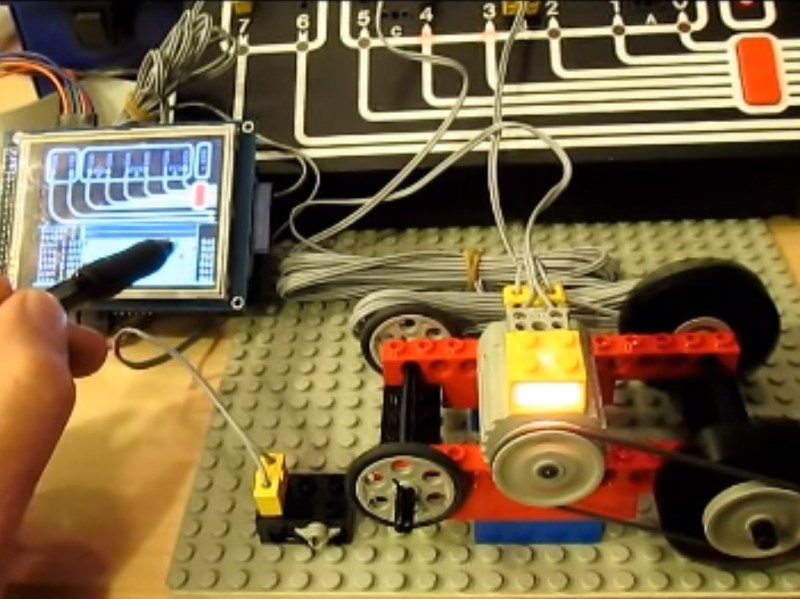[JAC_101], the Director of Legal Evil Emeritus for LVL1 Hackerspace (don’t ask me, it’s their title system), was challenged to a hacking duel. It all started years ago. The person who is now president of LVL1, visited the space for the first time and brought with her a discarded Apple II controller for Lego bricks which had previously belonged to her father. Excited to test it, the space found that, unfortunately, LVL1’s Apple II wouldn’t boot. An argument ensued, probably some trash talking, and [JAC_101] left with the challenge: Could he build an Arduino interface for the Apple II Lego controller quicker than the hackerspace could fix its Apple II?”

In the end, a concentrated force by one hacker over two years overcame the collective ADHD of many. He began by opening the interface to look inside, a completely unnecessary step since he found it was already thoroughly documented. Next he forgot about the project for a year. Then he remembered it, and built an interface for an Arduino Uno to hook to the controller and wrote a library for the interface. Realizing that sending serial commands was not in line with the original friendly intention of the device, he added a graphical display to the project; which allowed the user to control the panel with touch. In the end he won the challenge and LVL1 still doesn’t have a working Apple II. We assume some gloating occurred. Some videos of it in action after the break.

















“Next he forgot about the project for a year.”
Sounds like •every• one of my projects.
Dito
I feel like the main weakness of the Hackaday Prize was that it didn’t allow makers to forget about it for a year.
Nice, very nice, never knew there were such a thing, but fix the damn Apple II too. I bet Dr. Evil has a working Apple II.
I heartily approve of any hack or project that involves Lego. Period. ‘Nuff said.
Oh man I haven’t thought about this in years. Lego Logo it was called. Lego came up with this educational system that built on top of their Technic line. It was basically a breakout box for the Apple II that led to these Lego-styled pluggable wires. There were outputs available (mainly for running motors and lights), but you also had access to some inputs – things like switches and light sensors. The whole thing was programmed in some variant of Logo (you know, the one with the turtle) and could be used to make robot cars or whatever. Of course everything had to stay wired to the box to work, so your cars couldn’t go too far, but it was still tons of fun.
Instructions came with the set that would show you how to build things like a conveyor belt that stopped when items on it were at the end, a timed traffic light, an automated finish line for downhill Lego racecars, etc. One of the wheels for the motor had black-and-white patterning and could be used for a rotary encoder. The whole thing was pretty damn expensive… typical for Lego I guess. My dad took me to a demonstration of this in action at a local community college. Later our school district bought a few sets and I got to play with it in class.
The successor, I guess, would be Mindstorms.
I wish our school had made the investment, and cost would be the reason no child ever had one of these. Standard Lego were expensive enough but this Technic kit had to be expensive. Couple that with the cost of an Apple 2 and your folks likely stroked out.
Some more info here:
http://lukazi.blogspot.com/2014/07/lego-legos-first-programmable-product.html
I remember when I was little, Lego had a motor module that was basically a big block that you could plug 4 wheels into (train wheels or regular ones), not at all like the video. And they had lights like the one that’s shown in the video. Later on, when Lego started with the Technic series, I had already switched to FischerTechnik from Germany, to play with gears and lights and electromechanics and stuff.
FischerTechnik is not as old as Lego but it does predate Lego Technik by about 10 years. I didn’t know about the Lego computer interface but I do know that FischerTechnik came up with a computer interface in 1984, and it worked with various different computers such as the Apple II, Commodore PET, C64, TRS-80 and later the Amiga, IBM PC, Amstrad and others. I wonder if Lego made any interfaces for other computers than the Apple II?
FischerTechnik have replaced and updated their interfaces many times ((http://www.ftcommunity.de/ftComputingFinis/ftdetail.htm), the latest one (not mentioned on that web page) runs Linux on an ARM computer, has a touch screen, USB and Bluetooth. The earliest FischerTechnik interfaces aren’t compatible with current computers anymore because they required bitbanging the parallel port, but they can easily be used with an Arduino, which is what I did with my GPS-controlled FischerTechnik clock featured here a while ago (https://hackaday.io/project/7679).
I wonder why FischerTechnik is so unknown here in the USA. It’s massively popular in Europe (especially Germany and the Netherlands) as far as I can tell.
“I wonder if Lego made any interfaces for other computers than the Apple II?”
Yes, Mindstorms. The original had an IR transceiver that connected to a PC (or Mac?) via serial port (and later USB, IIRC). I don’t know what the NXT stuff uses. Bluetooth?